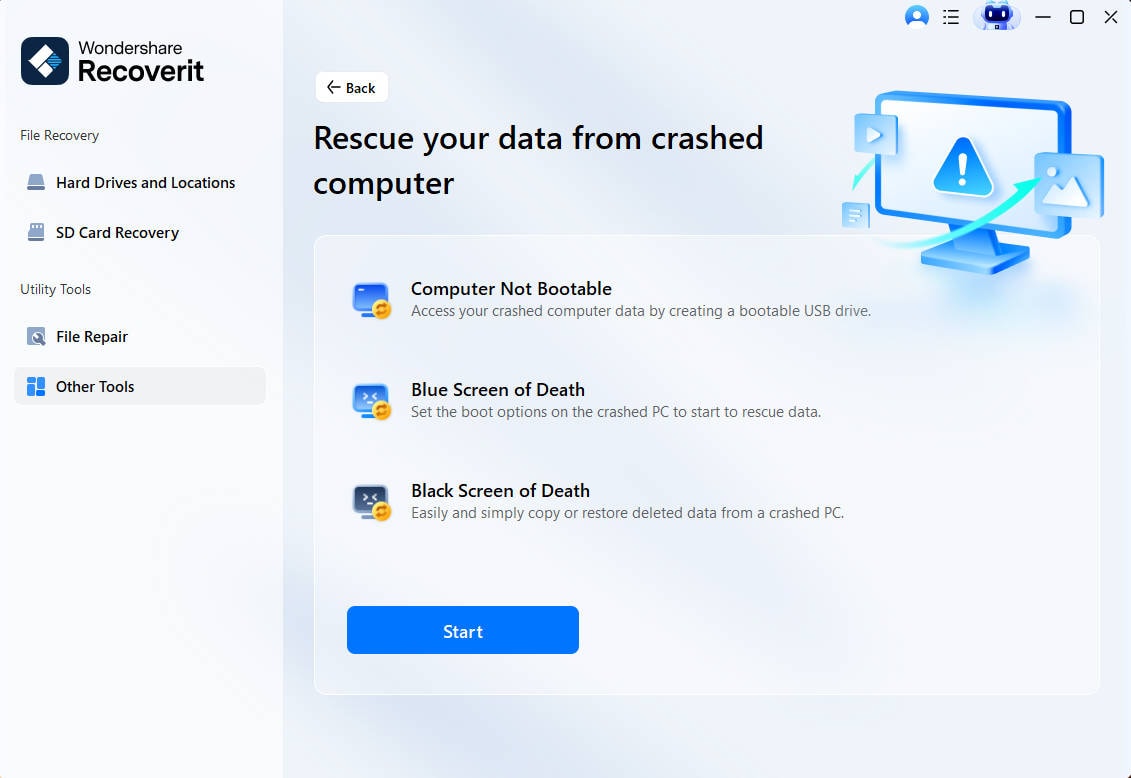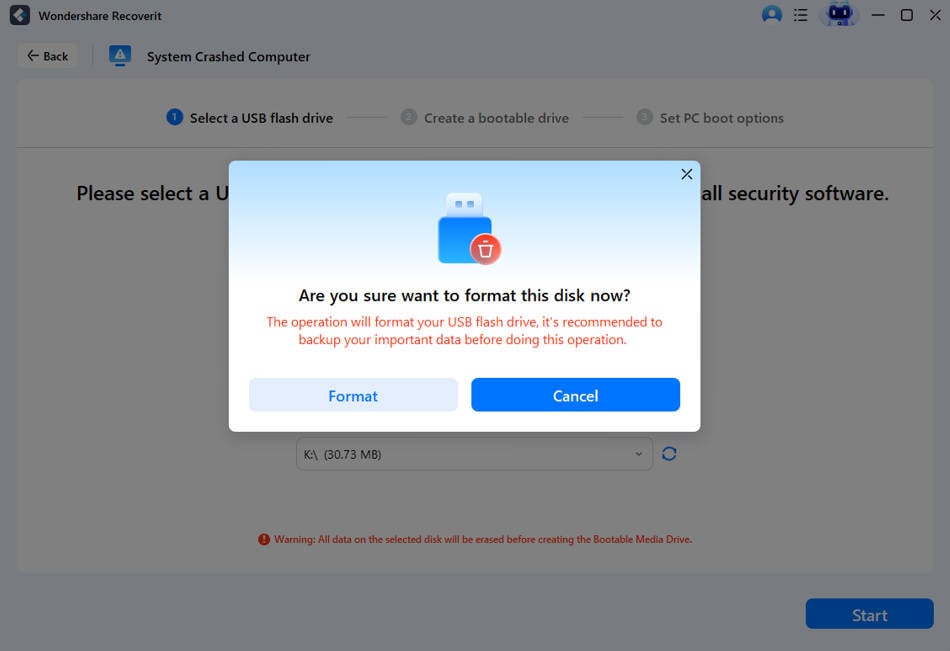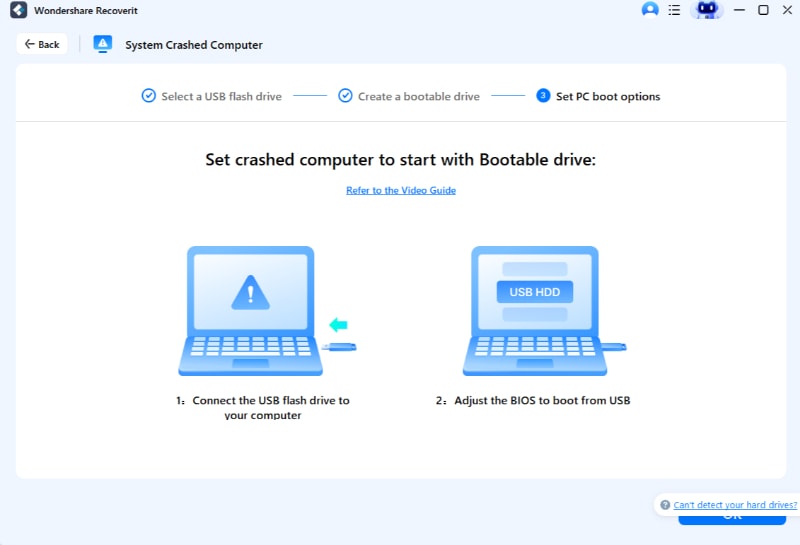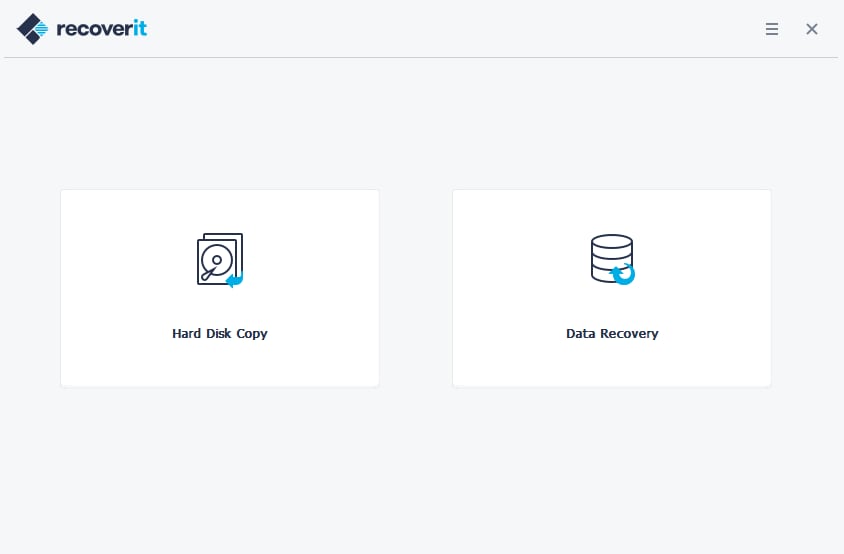"MyPC won’t start. I need to access important files. What can I do to get my data back when my PC isn't working?"
Your PC isn't starting, which can be very stressful if you have important data stored on it. Whether it's work documents, special photos, or crucial financial records, the idea of not being able to access your files can be very upsetting.
In this detailed guide, we'll look at why your computer isn't starting and give you step-by-step advice to fix your system. Most importantly, we'll teach you how to get your data back even when your PC isn't working.
In this article
Part 1: Why My Computer Won't Boot Up? Top Reasons
Stuck with the “My computer is not turning up” problem? Before we explore solutions, it's crucial to understand why your PC is not turning on in the first place. Here are some of the most common reasons why your computer won't boot up:
- Power supply issues: Your PC is not turning on but has power, yet the power supply unit (PSU) might be faulty.
- Corrupted operating system: System files essential for booting may be damaged or missing.
- Hardware failure: Components like the hard drive, RAM, or motherboard could be malfunctioning.
- BIOS/UEFI problems: Incorrect settings or outdated firmware can prevent booting.
- Malware infection: Severe virus infections can render a system unbootable.
- Overheating: Accumulated dust or failing fans can cause thermal shutdown.
- Loose internal connections: Cables or components may have come unseated.
- Failed Windows updates: Incomplete or corrupted updates can disrupt the boot process.
- Driver conflicts: Incompatible or corrupt drivers can prevent Windows from starting.
- Physical damage: Liquid spills or impact damage can cause boot failure.
Understanding these potential causes is the first step in diagnosing why your computer is not turning up and finding the appropriate solution to recover your data and get your system running again.
Part 2: How To Fix The My Computer Won't Boot Up Issue
When faced with a PC that's not turning on, it's essential to approach the problem methodically. Each of the following fixes addresses a specific potential cause of boot failure. We'll explain why each method is important, how it helps, and provide simple steps to implement the solution.
Fix 1: Plug Your Computer to Power
Often, the simplest explanation is the correct one. Before assuming a catastrophic failure, it's crucial to ensure your PC is receiving power.
Verifying the power connection can quickly rule out basic power supply issues and potentially resolve the problem without further intervention.
Check for these signs and follow:

- Check that the power cable is securely plugged into both the PC and the wall outlet.
- Try a different wall outlet to rule out problems with the power source.
- If using a laptop, ensure the battery is properly seated and try connecting the AC adapter.
- Look for any lights on the PC case or power supply that indicate power is reaching the system.
Fix 2: Check Monitor
Sometimes, the issue isn't that your computer won't boot up, but rather that you can't see that it has booted.
Verifying monitor connections and functionality can reveal that your PC is actually running, just not displaying output.
Simple tips:

- Make sure monitor is turned on.
- Check that the video cable is securely connected to both the monitor and the PC.
- Try a different video cable or port if available.
- Test the monitor with another device to confirm it's functioning correctly.
Fix 3: Listen to the Beep Sound
Many computers emit diagnostic beep codes during startup that can indicate specific hardware issues.
Identifying these beep codes can pinpoint the exact component causing the boot failure, streamlining the troubleshooting process.
Simple steps:
- Power on your PC and listen carefully for any beep sounds. Count the number of beeps and note any pattern (e.g., short beeps, long beeps).

- : Visit the motherboard manufacturer's website to decode the beep pattern. Address the indicated hardware issue (e.g., reseating RAM, checking CPU installation).
Fix 4: Scan for Malware
A built-in feature of Windows called Virus & Threat Protection can be applied to protect computers from viruses and even get rid of viruses. To use this function on your PC and get rid of the virus right away, follow the steps below:
- Right-click the Windows icon and select "Settings."
- Go to "Update & Security" and click "Open Windows Defender Security Center."

- Click "Virus & threat protection" and then go to "Virus & threat protection settings."
- Turn on the "Virus & threat protection" switch. Windows Defender will then automatically scan your system for viruses.

- Turn on this Real-time protection, Cloud-delivered protection, and Automatic sample submission.
Fix 5: Disconnect External Devices and Restart PC
External devices can sometimes conflict with the boot process or draw too much power, preventing startup.
Removing these potential sources of interference allows you to isolate whether the boot issue is internal or caused by peripheral devices.
Simple steps:
- Shut down your PC completely. Unplug all external devices (except keyboard and mouse for desktops).

- Disconnect any USB drives, external hard drives, printers, and other peripherals. Attempt to boot your PC again with minimal connected devices.
Fix 6: Boot Into Safe Mode
Safe Mode starts Windows with a minimal set of drivers and services, which can help bypass software-related boot issues.
If your PC boots in Safe Mode, it indicates that the core operating system is intact, narrowing the problem to drivers, startup programs, or recent changes.
Simple steps:
- Restart your PC and repeatedly press F8 (or Shift + F8 for Windows 10) before the Windows logo appears. Select "Safe Mode" from the Advanced Boot Options menu.

- If successful, use Safe Mode to uninstall recently added software, update drivers, or run malware scans. If Safe Mode works, try a normal boot afterward to see if the issue is resolved.
Fix 7: Roll Back a Problematic Windows Update
Windows updates, while crucial for security and functionality, can sometimes introduce compatibility issues or bugs that prevent booting.
Reverting recent updates can restore system stability and allow your PC to boot normally, giving you time to address the underlying issue.
Simple steps:
- Boot into Safe Mode if possible (see Fix 5). Open Control Panel. Head to"Programs and Features".

- Click "View installed updates" on the left sidebar. Sort updates by date and uninstall the most recent ones. Restart your PC and check if it boots normally.
By systematically working through these fixes, you can often resolve the issue of your computer not turning up. However, if your PC still won't boot after trying these methods, it's time to focus on data recovery.
In the next section, we'll explore how to recover data when your PC won't boot, ensuring that even if your computer is not turning on, you can still retrieve your valuable files.
Part 3: Lost Files? Recover Data When PC Won't Boot With Recoverit Software
When all attempts to boot your computer have failed, your priority shifts to recovering your valuable data. Isn’t it? Even if your PC is not turning on, there are still ways to access and retrieve your files.
One of the most effective methods is using specialized data recovery software like Recoverit.
Recoverit is a powerful tool that can recover data when your PC won't boot. It works by creating a bootable USB drive on a working computer, which you then use to start your non-booting PC and run the recovery process. This method allows you to recover data from no boot computer without risking further damage to your system.
Step-by-step guide to recover data when PC is not turning on using Recoverit:
- Prepare a working computer and a USB drive (at least 8GB). Install Recoverit on the working computer. Launch Recoverit and select the "System Crashed Computer" recovery mode.

- Follow the on-screen instructions to create a bootable USB drive.

- Once the bootable drive is ready, insert it into the PC that won't boot. Hit the “Format” button.

- Start the non-booting PC and enter the BIOS/UEFI settings (usually by pressing F2, F12, or Del during startup). Your PC should now boot from the USB drive and launch Recoverit.

- Select the “Data Recovery” option.

Why Recoverit is Effective:
Recoverit uses advanced algorithms to locate and recover files even when the file system is damaged or inaccessible through normal means. It can recover data from a PC that won't boot due to various issues, including:
- Operating system corruption
- Hard drive failure
- Virus attacks
- Accidental system formatting
- Blue screen of death errors
By using Recoverit, you can often recover data from a crashed computer without needing expensive professional services. This software provides a lifeline when your computer is not turning up, allowing you to retrieve documents, photos, videos, and other important files.
Bonus Video Tutorial: Computer Stuck at BIOS Screen
Part 4: Tips to Avoid the PC Won't Boot Problem
Here are some essential tips to help you avoid situations where your computer won't boot up:
- Regularly back up your data: Use cloud storage or external drives to keep copies of important files.
- Keep your operating system and drivers updated: Regular updates patch security vulnerabilities and fix bugs that could cause boot issues.
- Use antivirus software: Protect your system from malware that could corrupt your OS and prevent booting.
- Monitor your hard drive health: Use built-in tools like SMART or third-party software to detect early signs of drive failure.
- Avoid sudden shutdowns: Always use the proper shutdown procedure to prevent file system corruption.
- Use a UPS (Uninterruptible Power Supply): Protect your PC from power surges and unexpected outages.
- Clean your PC regularly: Dust buildup can cause overheating, leading to hardware failure and boot problems.
- Be cautious with third-party software: Only install trusted programs to avoid potential conflicts or malware.
- Create a system restore point before major changes: This allows you to roll back if a change causes boot issues.
- Keep a bootable recovery drive handy: Prepare a USB drive with recovery tools before you need it.
By following these tips, you can significantly reduce the chances of encountering a situation where your PC is not turning on. However, it's always wise to be prepared for the worst-case scenario by having a data recovery plan in place.
Conclusion
Facing a computer that won't boot up can be a stressful experience, especially when you have important data at stake. However, as we've explored in this guide, there are numerous ways to troubleshoot and resolve boot issues, from simple power checks to more advanced recovery methods.
Remember, when your PC is not turning on, stay calm and approach the problem methodically. Start with the basics, like checking power connections and monitor settings, before moving on to more complex solutions. If all else fails, know that tools like Recoverit can help you recover data when your PC won't boot, ensuring that your files are not lost even if your computer is not turning up.
By combining these recovery techniques with preventive measures, you can protect your data and minimize downtime, keeping your digital life running smoothly.
Try Wondershare Recoverit to Recover Your Vital Data

FAQ
-
Q: Can I recover data from a PC that won't boot due to hardware failure?
Yes, you can often recover data when your PC won't boot, even with hardware issues. Use tools like Recoverit or remove the hard drive and connect it to another computer. -
Q: Is it safe to use data recovery software on a PC that's not turning on?
Yes, when used correctly, data recovery software like Recoverit is safe and doesn't risk further damage to your data or hardware. -
Q: What should I do if my computer is not turning on but has power?
Start by checking all connections, listening for beep codes, and trying to boot into Safe Mode. If these don't work, focus on data recovery methods.



 ChatGPT
ChatGPT
 Perplexity
Perplexity
 Google AI Mode
Google AI Mode
 Grok
Grok























